A comparison of adult rhabdomyosarcoma and high-grade neuroendocrine carcinoma of the urinary bladder reveals novel PPP1R12A fusions in rhabdomyosarcoma
- PMID: 30946934
- PMCID: PMC8078053
- DOI: 10.1016/j.humpath.2019.03.007
A comparison of adult rhabdomyosarcoma and high-grade neuroendocrine carcinoma of the urinary bladder reveals novel PPP1R12A fusions in rhabdomyosarcoma
Abstract
Some rhabdomyosarcomas and sarcomatoid carcinomas with heterologous rhabdomyosarcomatous elements resemble high-grade neuroendocrine carcinoma, creating a diagnostic difficulty. The purpose of this study was to characterize the overlap of adult genitourinary rhabdomyosarcomas, excluding those occurring at paratesticular sites, with high-grade neuroendocrine carcinoma and identify features helpful in their separation. Seventeen cases of rhabdomyosarcoma (11 from the urinary bladder and 3 each from kidney and prostate) were compared to 10 cases of high-grade neuroendocrine carcinoma from the urinary bladder. These tumors were analyzed by immunohistochemistry for desmin, MyoD1, myogenin, chromogranin, synaptophysin, CD56, TTF1, and ASCL1, and RNA sequencing was performed on 4 cases of bladder rhabdomyosarcoma (2 rhabdomyosarcomas and 2 sarcomatoid-rhabdomyosarcoma) and 10 cases of bladder high-grade neuroendocrine carcinoma. This was compared to public data from 414 typical urothelial carcinomas from The Cancer Genome Atlas dataset. Morphologic and immunophenotypic overlap with high-grade neuroendocrine carcinoma was seen in half of the bladder tumors, which included 4 rhabdomyosarcomas and 2 sarcomatoid rhabdomyosarcomas. RNA sequencing confirmed expression of neuroendocrine markers in these cases (2 rhabdomyosarcomas and 2 sarcomatoid rhabdomyosarcomas). Differential neuroendocrine differentiation was highlighted by ASCL1 protein expression only in high-grade neuroendocrine carcinoma. Moreover, both a pure alveolar rhabdomyosarcoma and sarcomatoid rhabdomyosarcoma of the urinary bladder demonstrated a fusion involving PPP1R12A. In summary, adult rhabdomyosarcomas of the urinary bladder are molecularly distinct from high-grade neuroendocrine carcinomas based on specific patterns of expression of myogenic and epithelial to mesenchymal transition-related transcription factors as well as the presence of a novel PPP1R12A fusion which is seen in a subset of cases.
Keywords: ASCL1; Genitourinary; High-grade neuroendocrine carcinoma; PPP1R12A; Rhabdomyosarcoma; Sarcomatoid carcinoma; Urinary bladder.
Copyright © 2019 Elsevier Inc. All rights reserved.
Figures
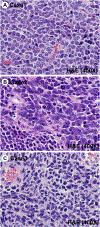

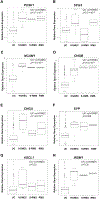
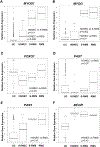

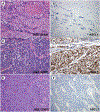
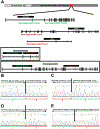
Similar articles
-
Small cell neuroendocrine carcinoma and poorly differentiated rhabdomyosarcomas of the urinary bladder in adults-A comparative analysis in favor of a common histogenesis.Virchows Arch. 2024 Oct;485(4):615-623. doi: 10.1007/s00428-024-03835-3. Epub 2024 Jun 4. Virchows Arch. 2024. PMID: 38833173 Free PMC article.
-
Rhabdomyosarcoma of the urinary bladder in adults: predilection for alveolar morphology with anaplasia and significant morphologic overlap with small cell carcinoma.Am J Surg Pathol. 2008 Jul;32(7):1022-8. doi: 10.1097/PAS.0b013e3181650e4a. Am J Surg Pathol. 2008. PMID: 18469707
-
Aberrant expression of epithelial and neuroendocrine markers in alveolar rhabdomyosarcoma: a potentially serious diagnostic pitfall.Mod Pathol. 2008 Jul;21(7):795-806. doi: 10.1038/modpathol.2008.86. Epub 2008 May 16. Mod Pathol. 2008. PMID: 18487991
-
[Non-urothelial tumors of the urinary tract].Verh Dtsch Ges Pathol. 1993;77:180-98. Verh Dtsch Ges Pathol. 1993. PMID: 7511278 Review. German.
-
"Pure" primary large cell neuroendocrine carcinoma of the urinary bladder: case report, literature review and diagnostic criteria.Pathologica. 2014 Jun;106(2):82-5. Pathologica. 2014. PMID: 25291874 Review.
Cited by
-
Small cell neuroendocrine carcinoma and poorly differentiated rhabdomyosarcomas of the urinary bladder in adults-A comparative analysis in favor of a common histogenesis.Virchows Arch. 2024 Oct;485(4):615-623. doi: 10.1007/s00428-024-03835-3. Epub 2024 Jun 4. Virchows Arch. 2024. PMID: 38833173 Free PMC article.
-
"Aberrant" expression of skeletal muscle markers in neuroendocrine carcinomas: a significant diagnostic pitfall.Virchows Arch. 2024 Oct;485(4):625-629. doi: 10.1007/s00428-024-03838-0. Epub 2024 Jun 4. Virchows Arch. 2024. PMID: 38833174
-
Introducing Fluorescence-Guided Surgery for Pediatric Ewing, Osteo-, and Rhabdomyosarcomas: A Literature Review.Biomedicines. 2021 Oct 4;9(10):1388. doi: 10.3390/biomedicines9101388. Biomedicines. 2021. PMID: 34680505 Free PMC article. Review.
References
-
- Ahlering TE, Weintraub P, Skinner DG. Management of adult sarcomas of the bladder and prostate. J Urol 1988; 140, 1397–1399. - PubMed
-
- Aydoganli L, Tarhan F, Atan A, Akalin Z, Yildiz M. Rhabdomyosarcoma of the urinary bladder in an adult. Int Urol Nephrol 1993; 25, 159–161. - PubMed
-
- Childs L, Hull D, Bostwick DG. Adult urinary bladder rhabdomyosarcoma. Urology 2008; 72, 948 e941–943. - PubMed
-
- Eusebi V, Damiani S, Pasquinelli G, Lorenzini P, Reuter VE, Rosai J. Small cell neuroendocrine carcinoma with skeletal muscle differentiation: report of three cases. Am J Surg Pathol 2000; 24, 223–230. - PubMed
Publication types
MeSH terms
Substances
Grants and funding
LinkOut - more resources
Full Text Sources
Medical
Research Materials

